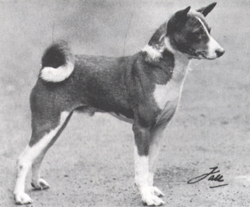 The first was, of course, The first was, of course,
Mrs. Burn's great BONGO
OF BLEAN (right): born
March 1935, he was very
short backed, and like most
native dogs, a dream of a
mover. He was unbeaten in
his show career. He picked
up distemper from which he
died. He only had the opportunity of siring less than
half a dozen litters, but even so, this was the start of the
breed in England.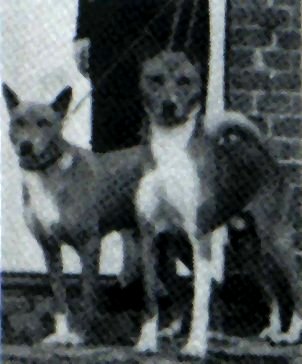
His most famous son was KWANGO
OF THE CONGO (left), again a very
sound dog with a wonderful head, but
rather long backed and much too high.
He was bred to his half sister, KOO-
KOO OF THE CONGO, who was sired
by Bongo, and they produced KINGA
OF THE CONGO, a much smaller and finer dog.
By this time in the development of the breed,
AMATANGAZIG OF THE CONGO, a bitch imported in
1938, had arrived in England from the Southern Sudan
and the combination of Kinga, Amatangazig and
Amatangazig's daughters set up a great line. In fact,
Basenjis became really established through them. The
in-breeding which had to be done now appears rather
horrifying, but there was no alternative. This is just
one example - Kinga was bred to Amatangazig and
produced Juba, Juba was bred to Kinga and produced
Fern and Brown Trout, who became the first Basenji
champions in the world. They were bred together and
April 17, 1947, produced BLACK MAGIC (left) and
BLACK IDOL OF THE CONGO (right), the first tri-
colored champion. Black Magic was then mated to his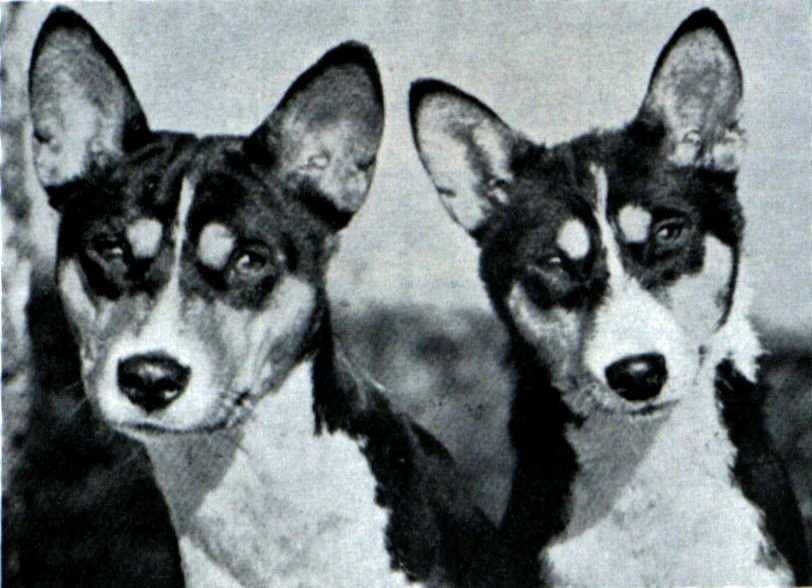
half sister, Black Myth
(also by Brown Trout)
and they produced the
first all tri litter known
outside Africa. Among
these pups was Int. Ch.
Black Ice, and Ch. Black
Rod, another famous
sire.
At this time we had a number of problems to contend
with, such as bad mouths, creams and serious inguinal
and scrotal hernias. I was very young in those days and
remember discussing it despondently with a wise and
well-known breeder, Mr. K. B. Smith. He told me that
one could in-breed to strength as well as to weakness,
and if one used careful selection such faults could be
bred out. I can never be sufficiently grateful to him for
such words of wisdom as time proved them to be true.
Another famous dog from the Kinga-Zig line was INT.
CH. VAGABOND OF THE CONGO, sire of many
champions, but possibly the biggest claim to fame was
being among the final ten exhibits for best in show at
one of the post-war Crufts shows. In those days we did
not have group judging and there must have been
around ninety dogs in the ring. I remember standing
there thinking that Basenjis were almost unknown so I
need not listen as to who was called in, and I had to be
top of page |
called three times and be pushed in by the other exhibit-
ors before I realized a Basenji was included in the final
best exhibits.
By the 1950's new blood was
desperately needed, so it was
the answer to a prayer when
Mr. and Mrs. Williams of the
Syngefield Basenjis, Eire, im-
ported Mr. Forest Hall's AM.
CH. KINGOLO (right), whelped
in December, 1945, from the
African imports Kindu and
Kasenyi, giving entirely new
blood which gave wonderful results when crossed with
the English and Irish stock. Mr. and Mrs. Williams bred
several champions from Kinglo and ANTEA OF SYNGE-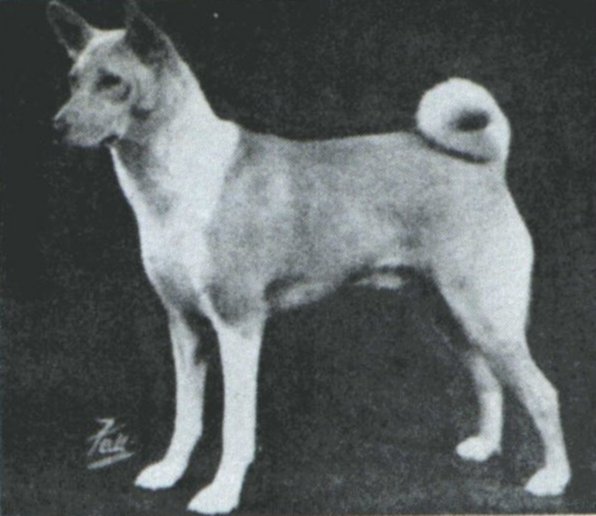
FIELD, chief of these being
the big winner, INT. CH.
LEDA OF SYNGEFIELD.
From Kingolo and BAMBOO
OF THE CONGO, Mrs.
Percival bred INT. CH.
SYNGEFIELD LEONATO
OF LITTLEBREACH (left),
born January 1954, CH. JAMY
and CH. JESSICA OF LITTLE-BREACH. I bred CH.
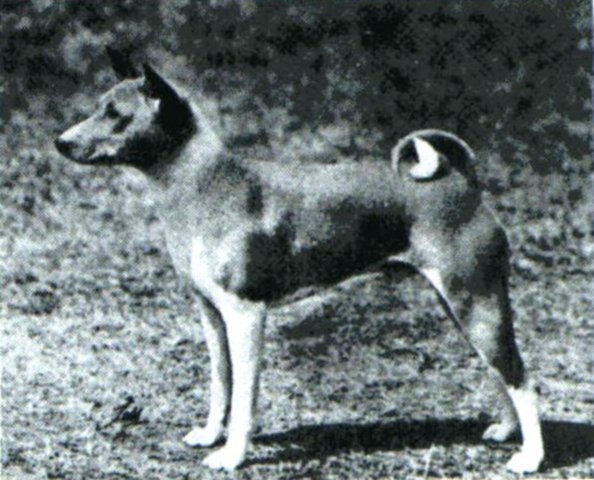 PETAL OF THE CONGO by PETAL OF THE CONGO by
Kinglo and out of INT. CH.
ORANGE FIZZ OF THE
CONGO, and Mrs. Anderson
bred the famous CH.
ANDERSLEY ATLANTIC
(right), born December 1954,
and CH. ANDERSLEY
AMERICANA from Kingolo
and GOLD COIN OF THE CONGO. This new blood
really set up the breed.
The next import was in 1952; WAU OF THE CONGO
(below) was from the Southern Sudan. My feelings were
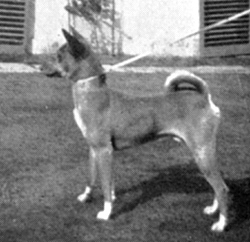 always mixed over this dog, always mixed over this dog,
and I never used him very
much for stud. I considered
his progeny varied too
much. There were large ears
and very small ears, very
fine coat and very heavy
coats; small pups and large
pups. Other breeders did
not agree with me and used
his blood considerably, saying it did more for their stock
than any other line, so his importation did some good
and could not be called a failure.
The last import (editor's note: at that time) was FULA
OF THE CONGO, also from the Southern Sudan. Her
first puppies were born eight years ago, and her
descendants FULA'S SON, CH FULAFUTURE and CH.
ST. ERME FULA FALCON OF THE CONGO have won
the Stud Dog Cup for the most winning progeny for the
past six years, but as they are among the living do not
come into an article entitled, "Great Stud Dogs of the
Past." |